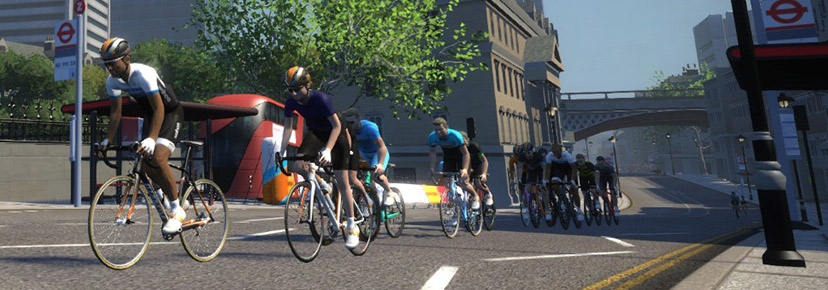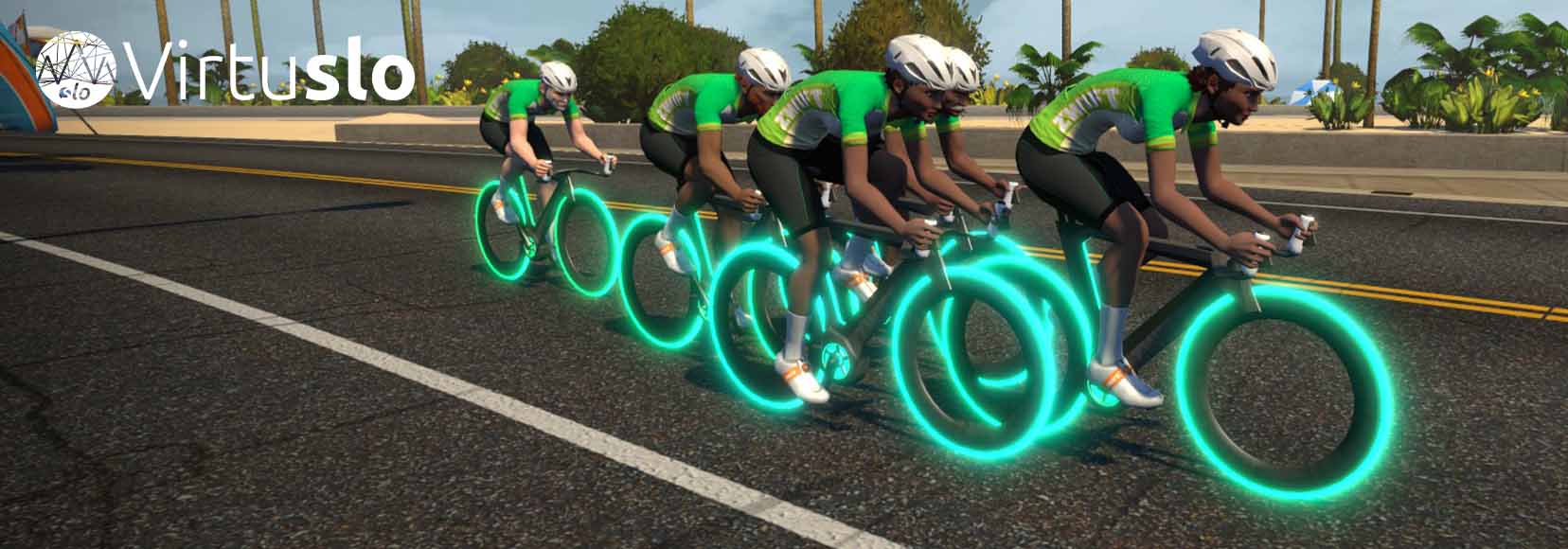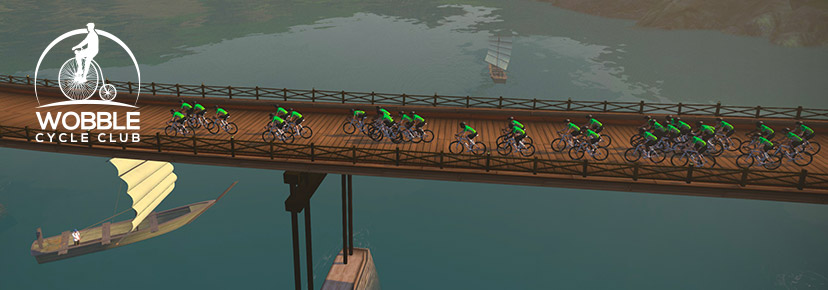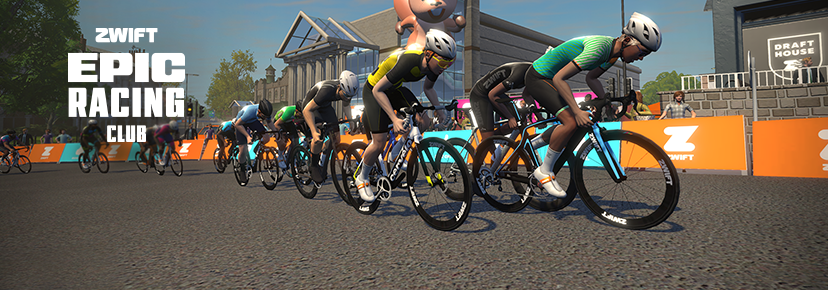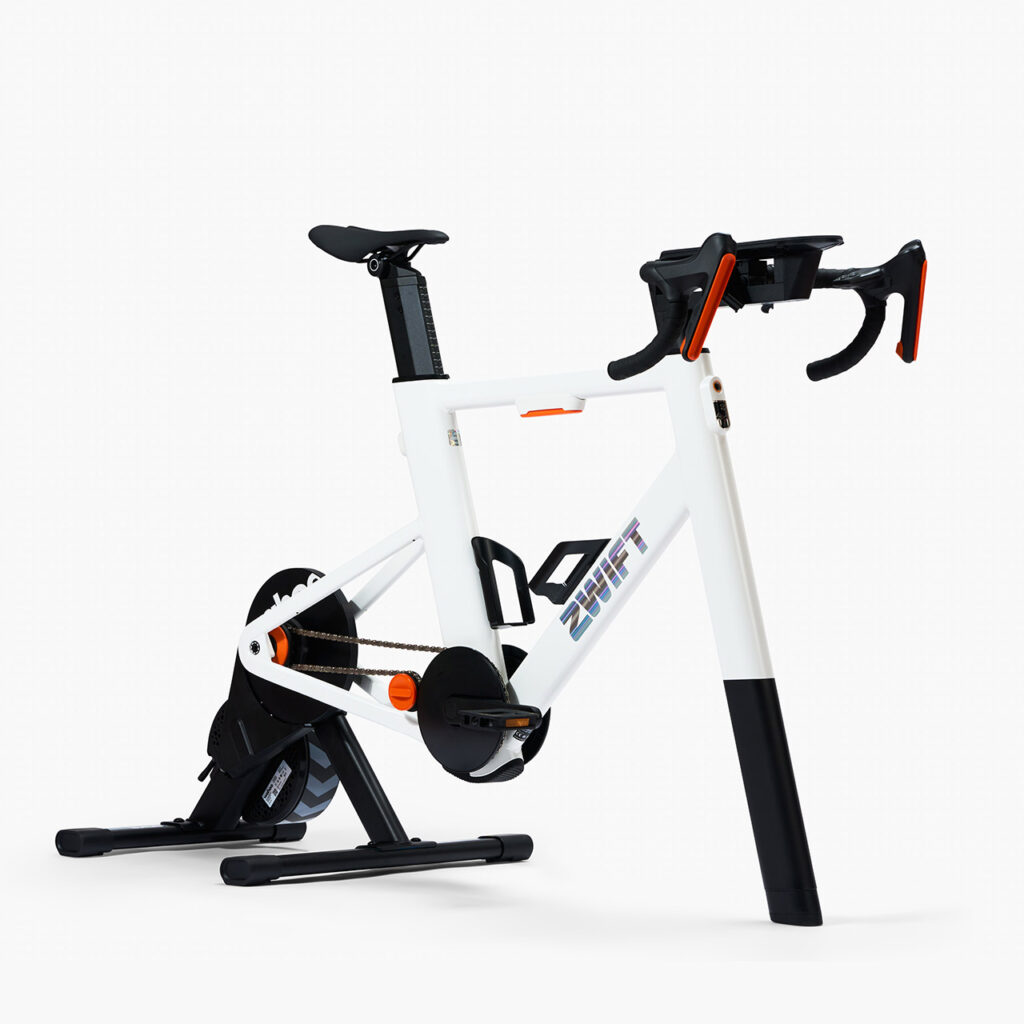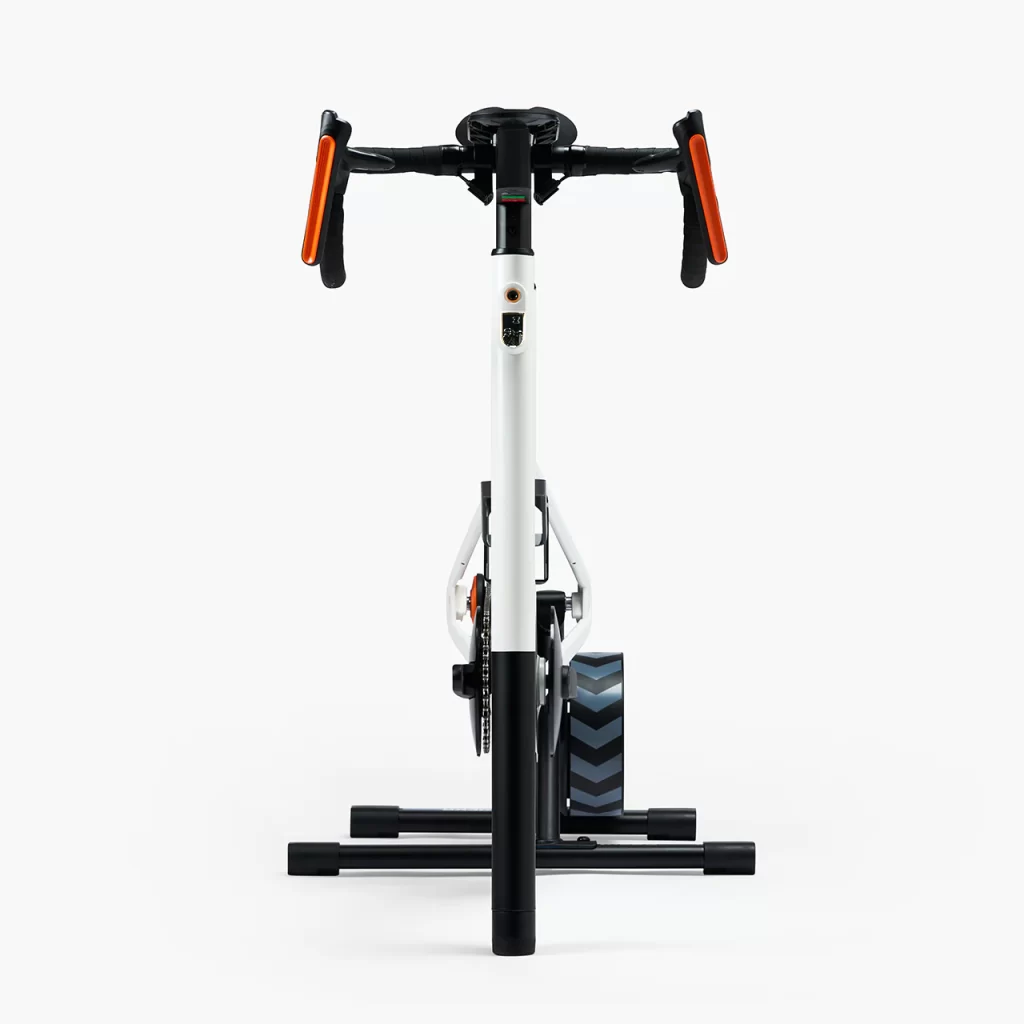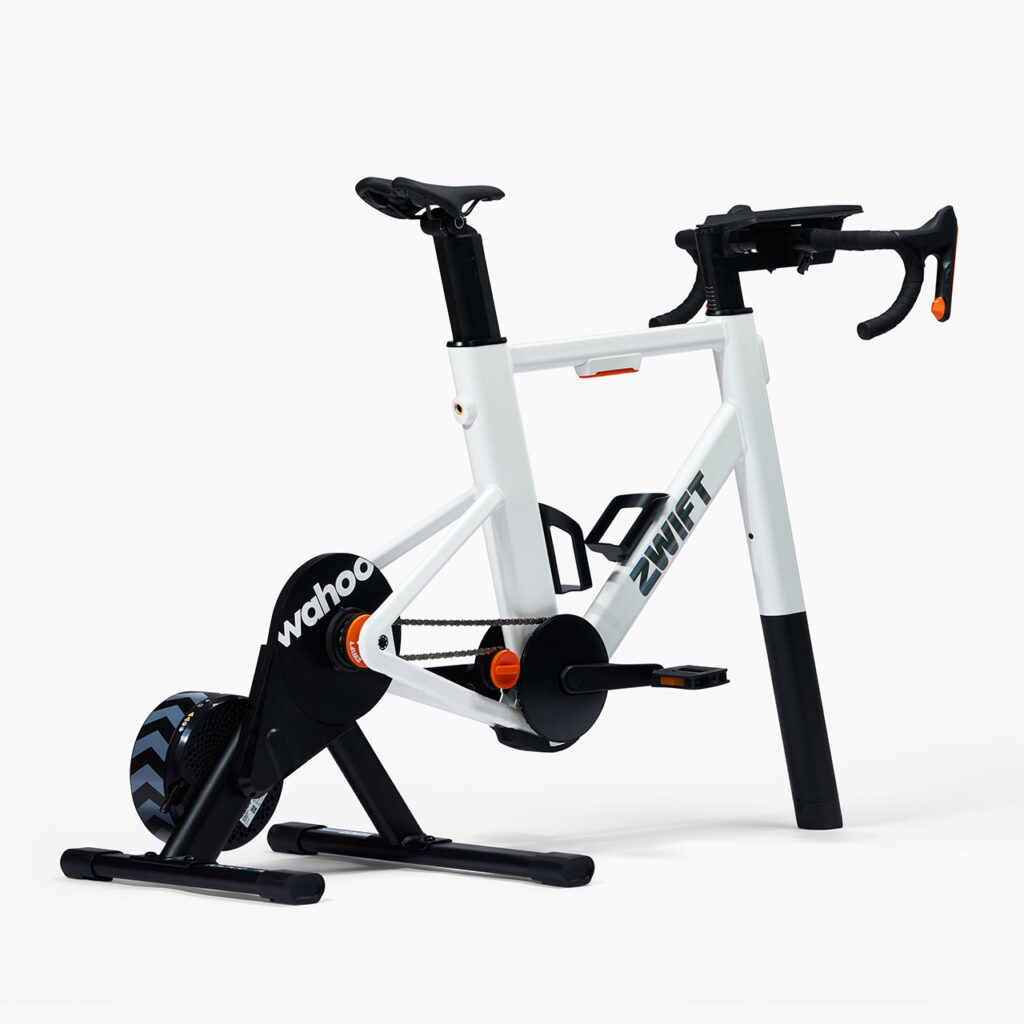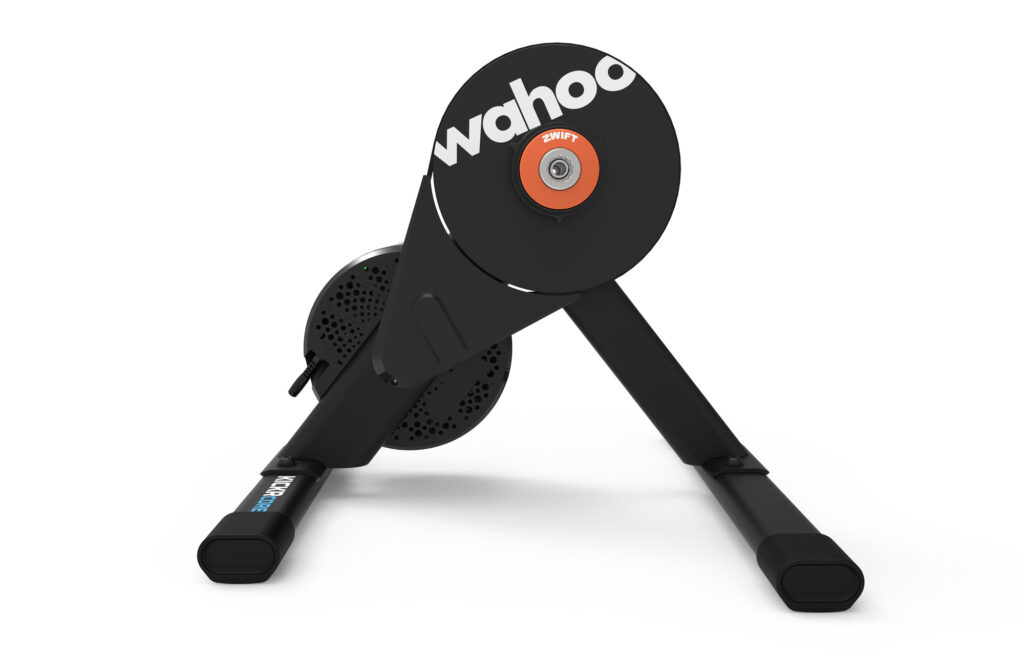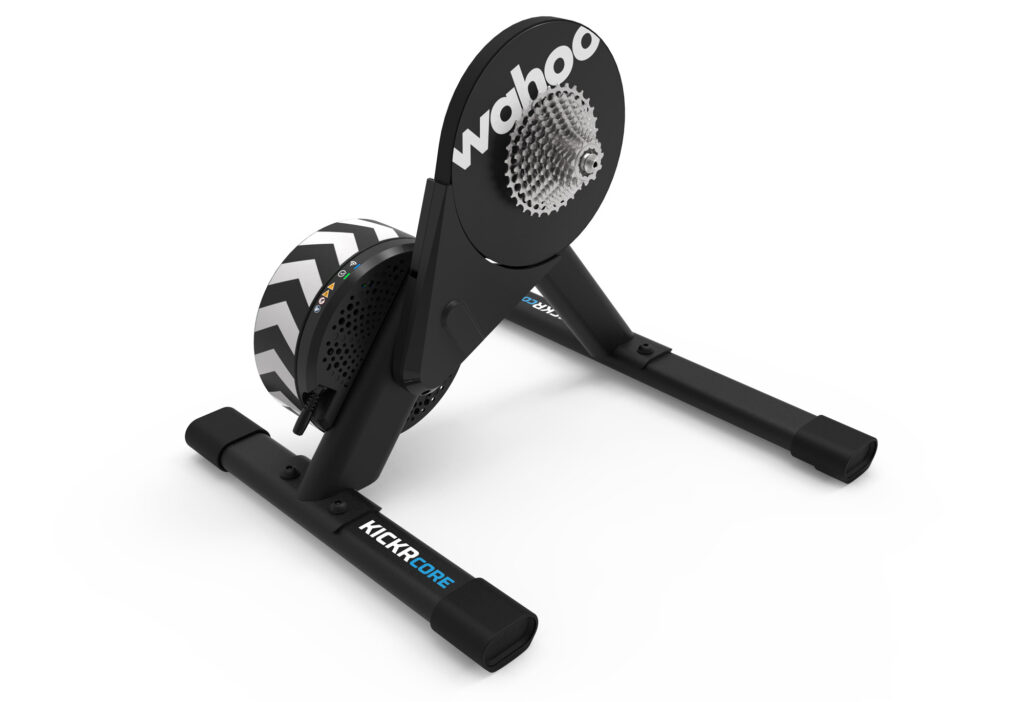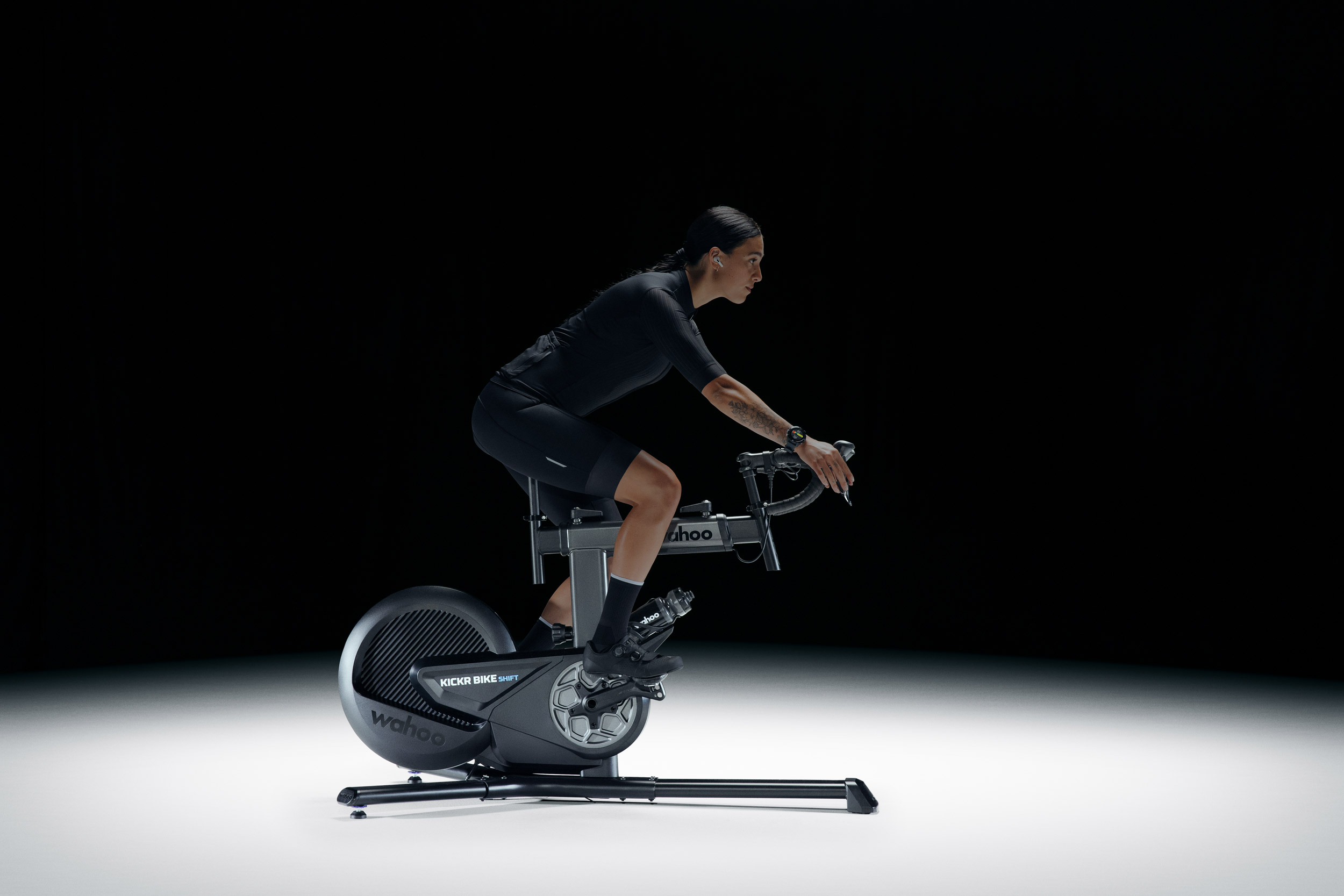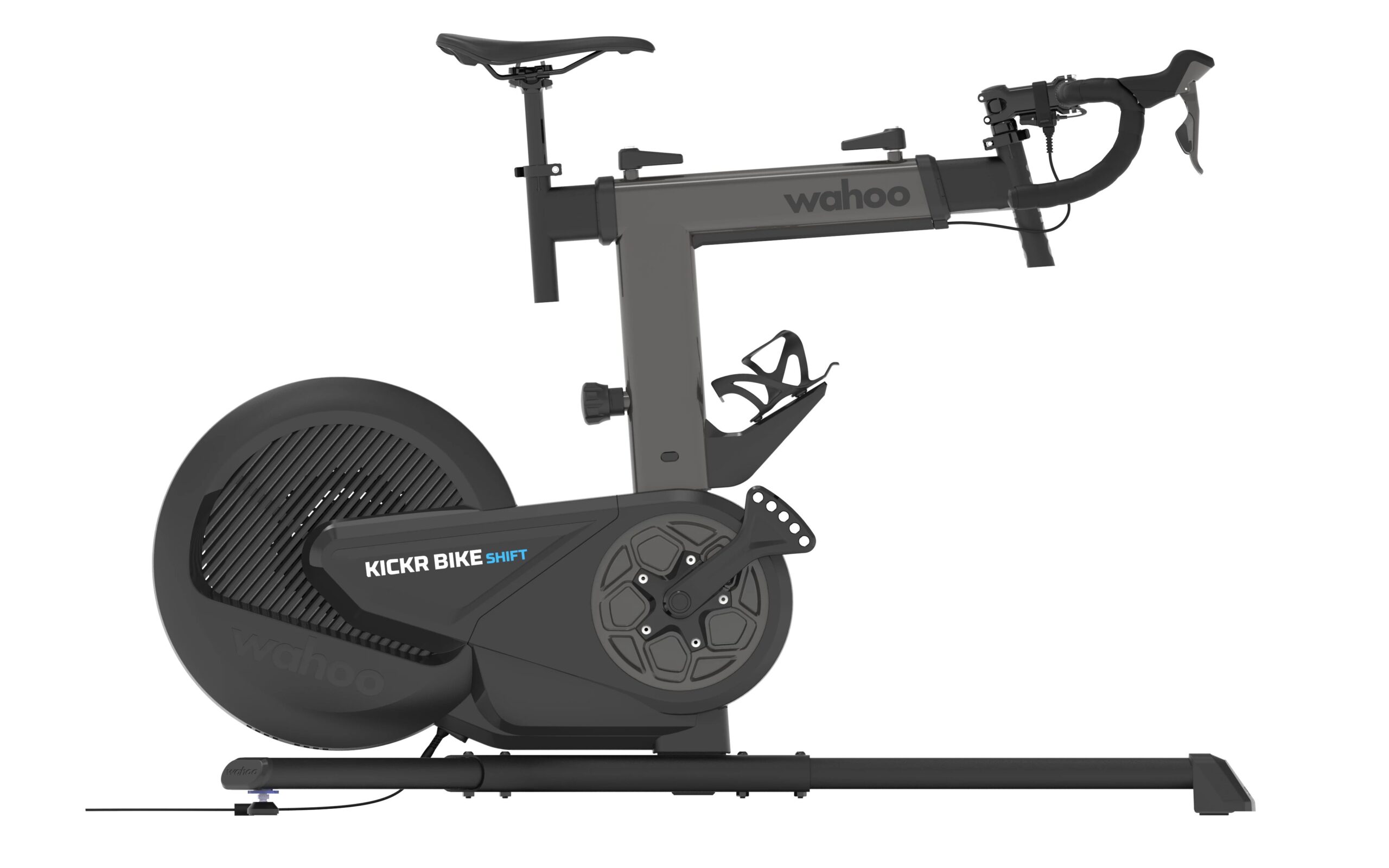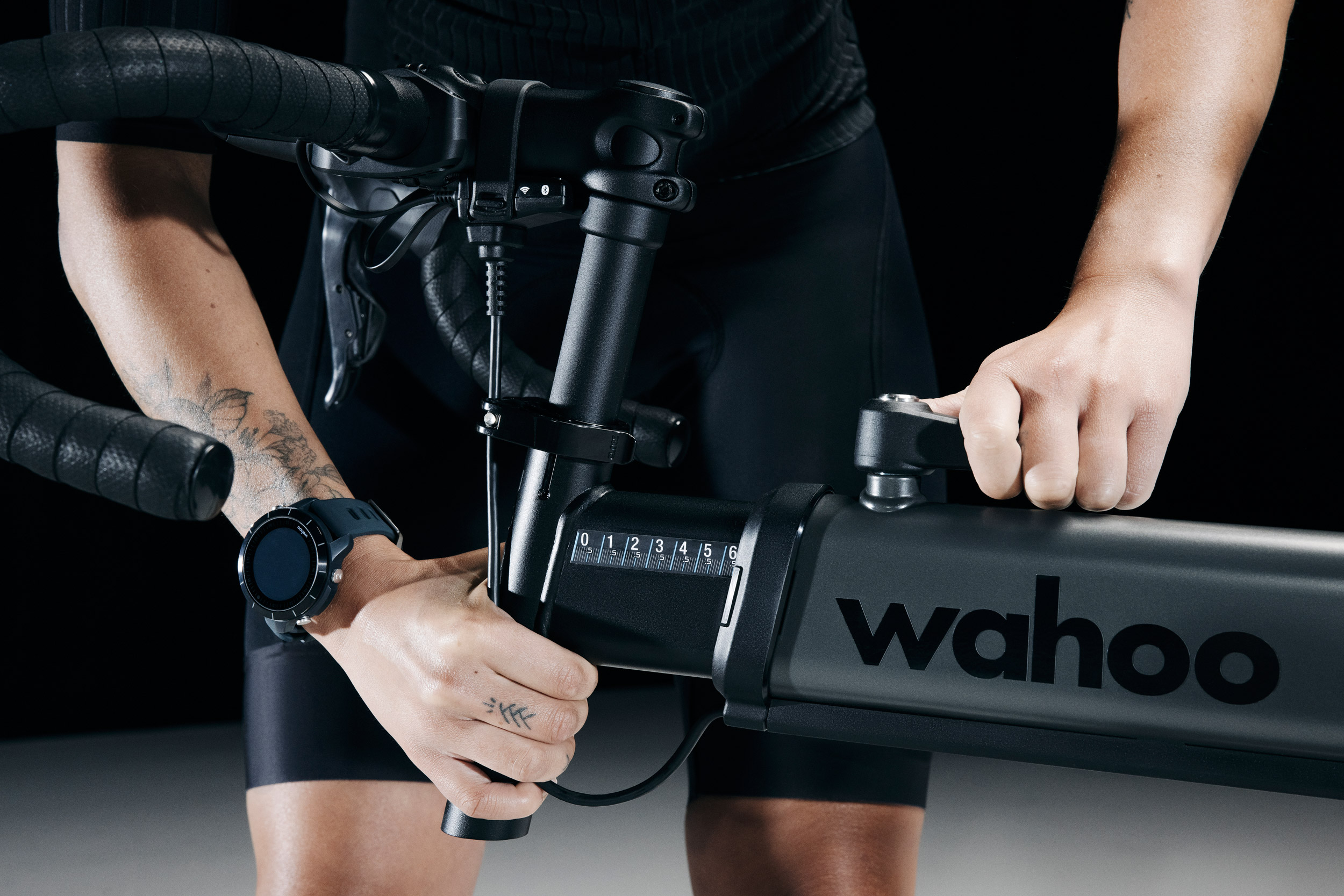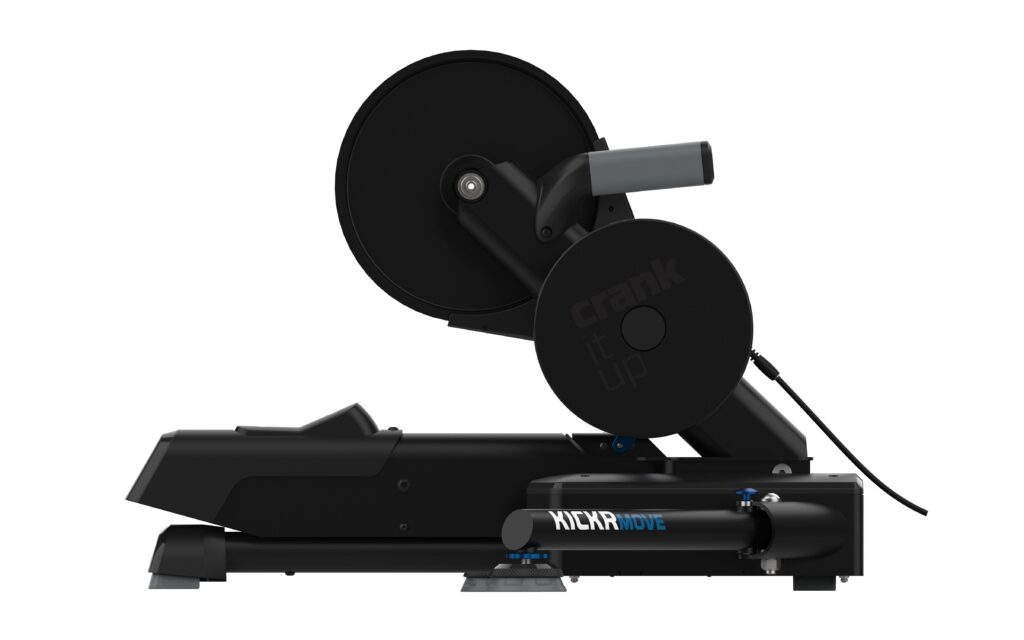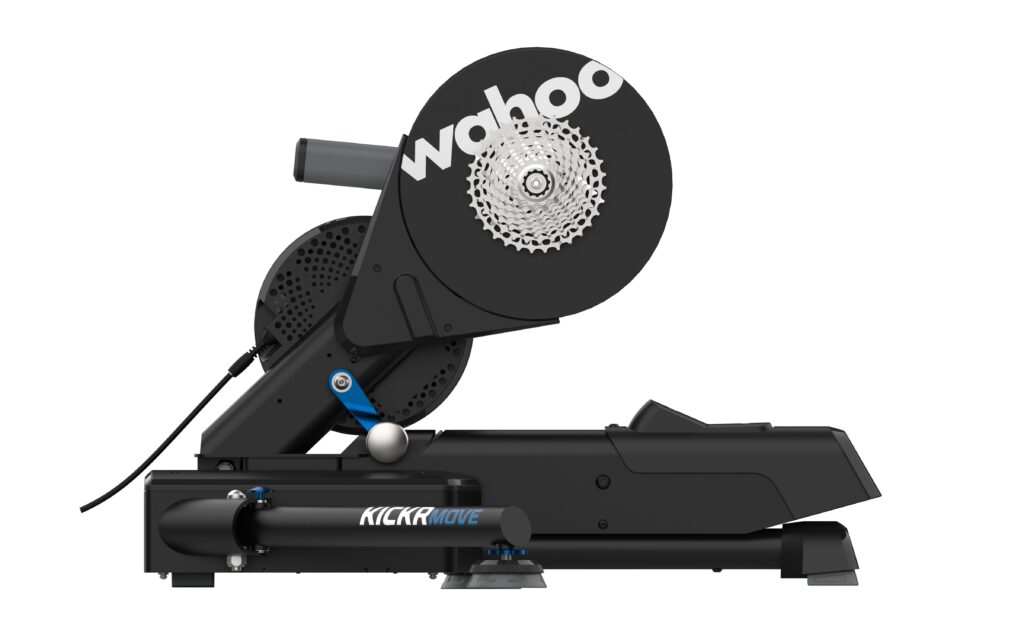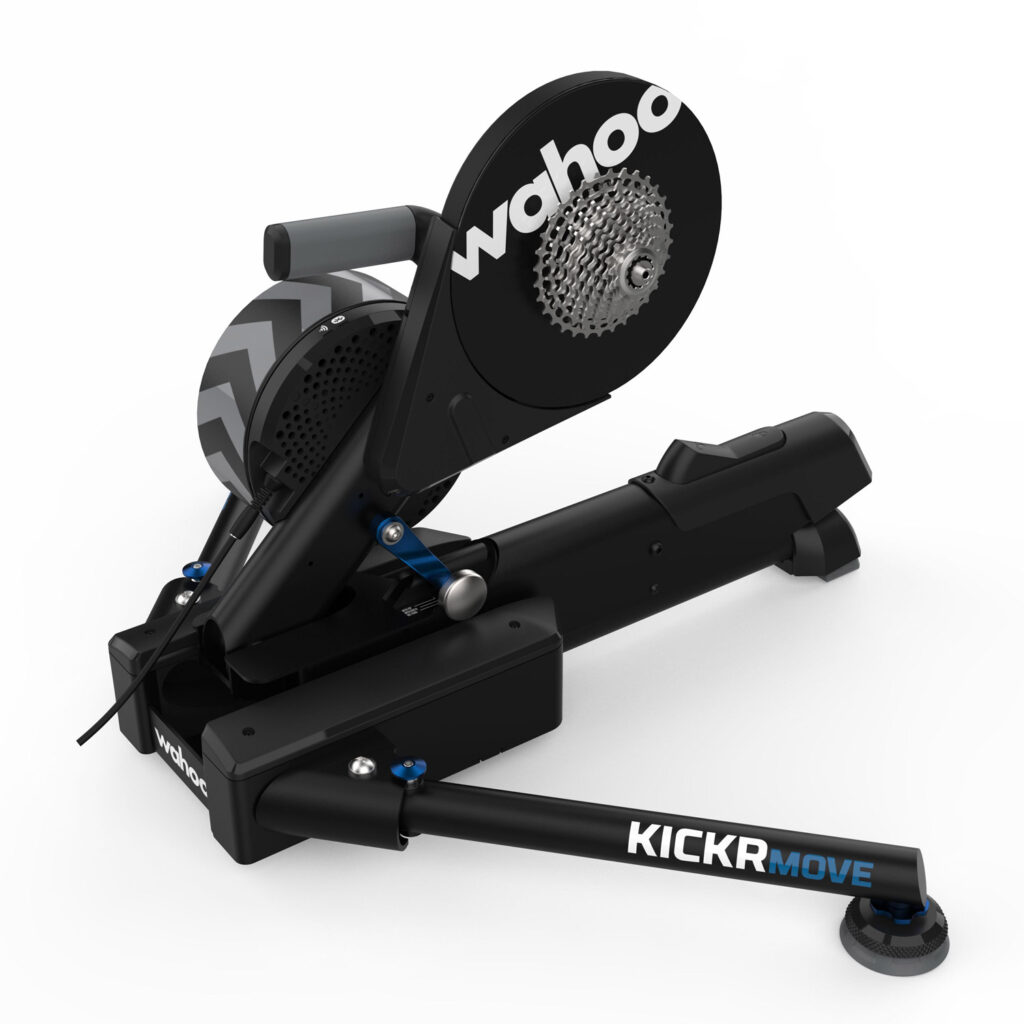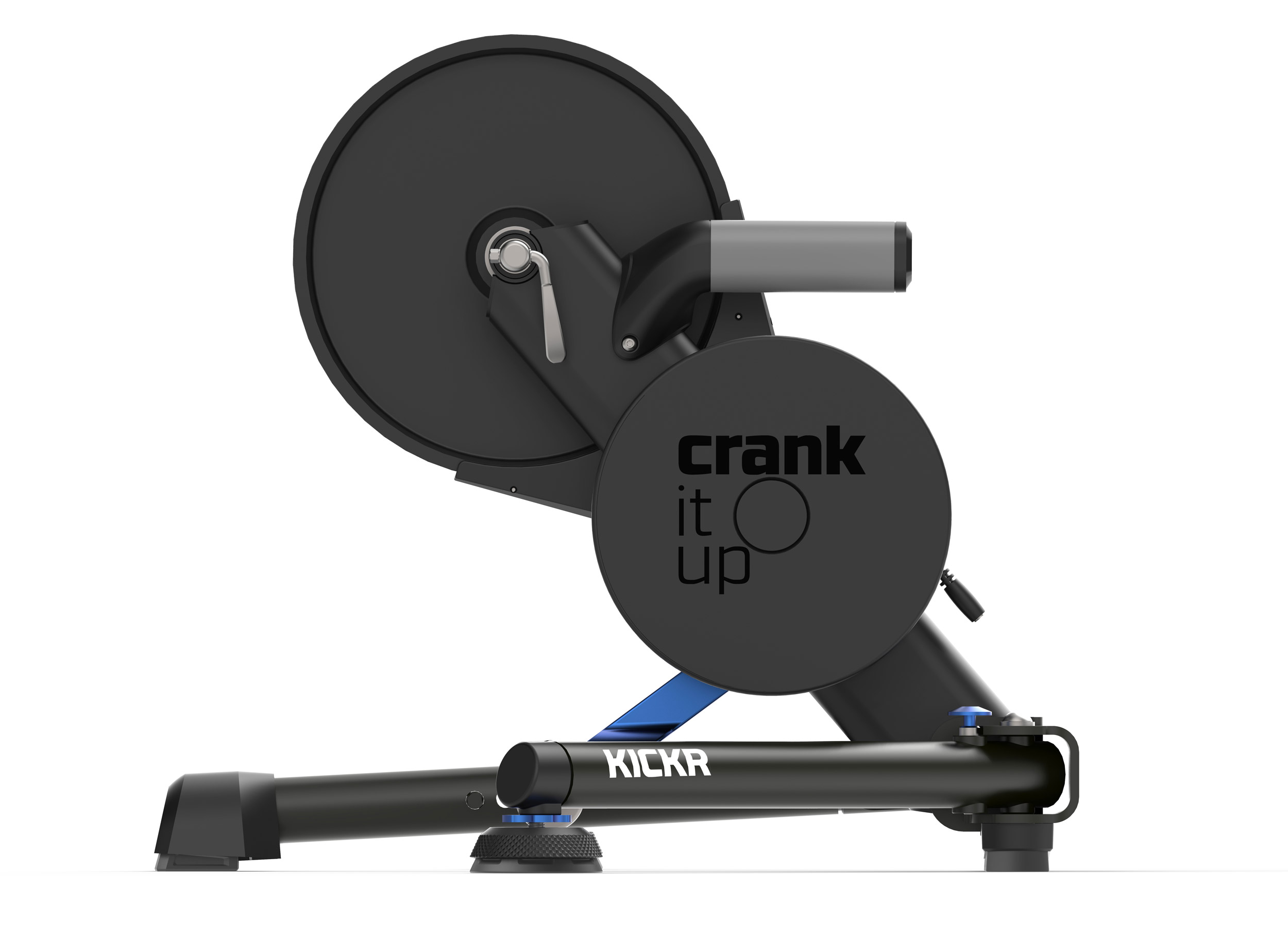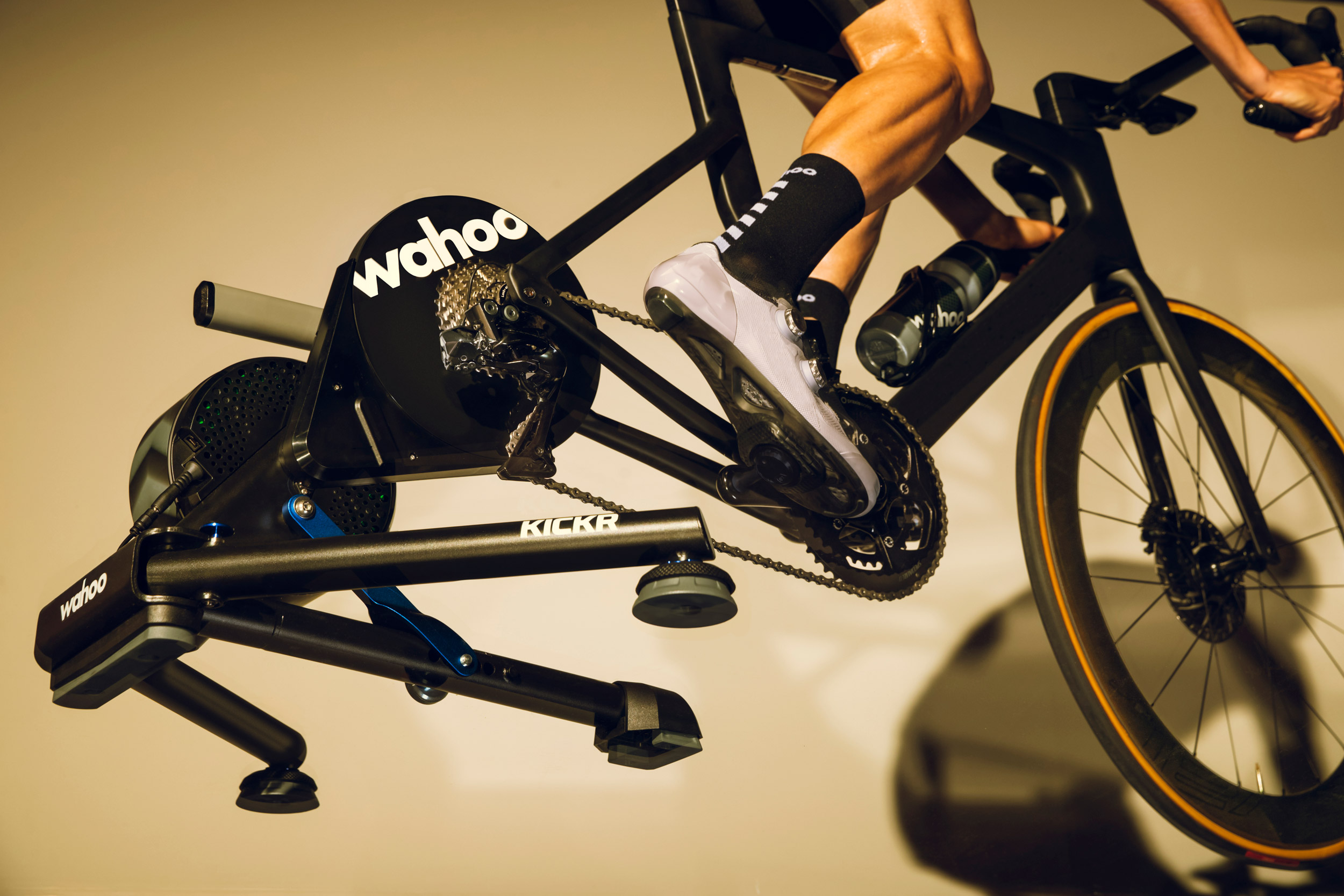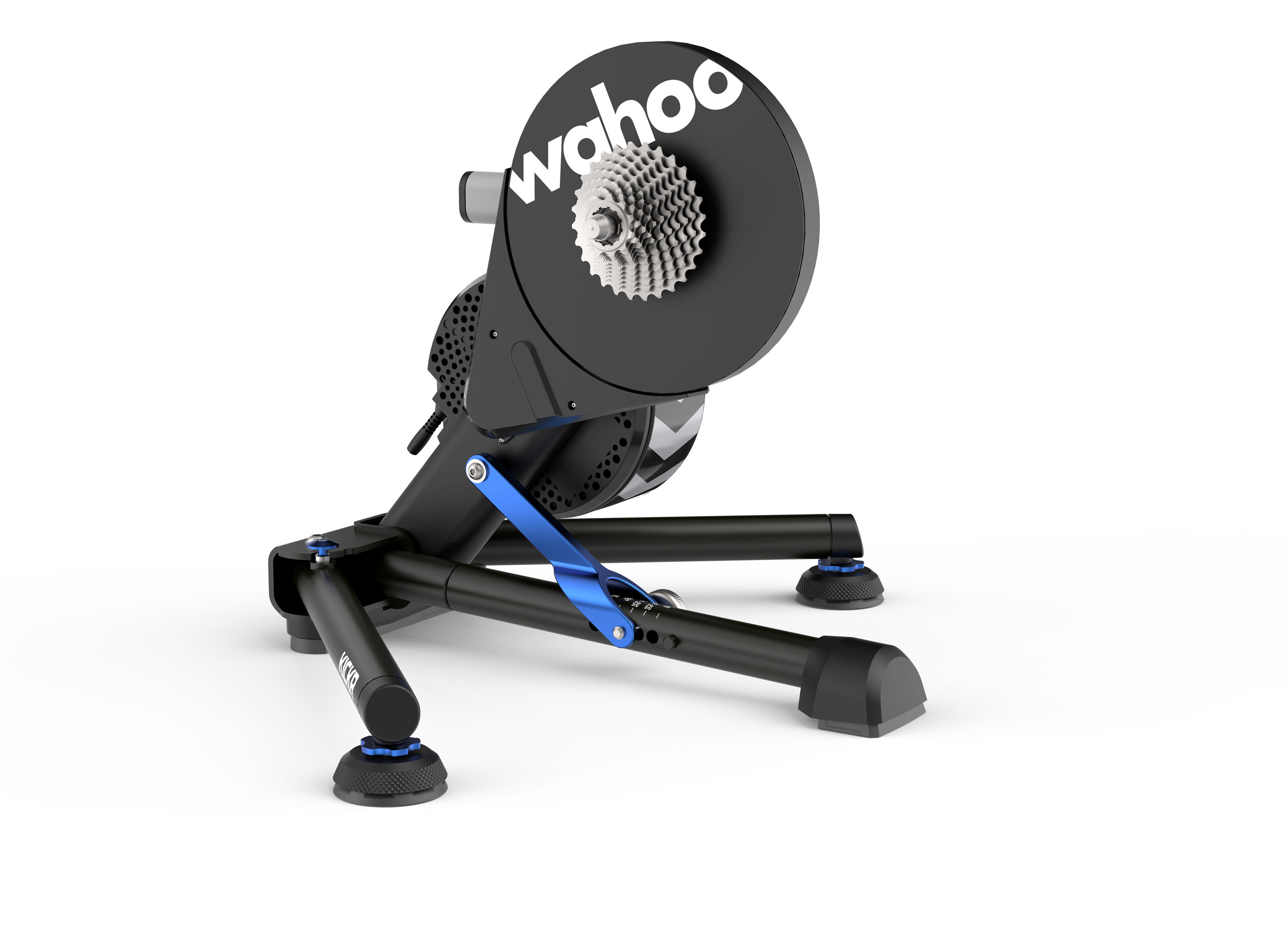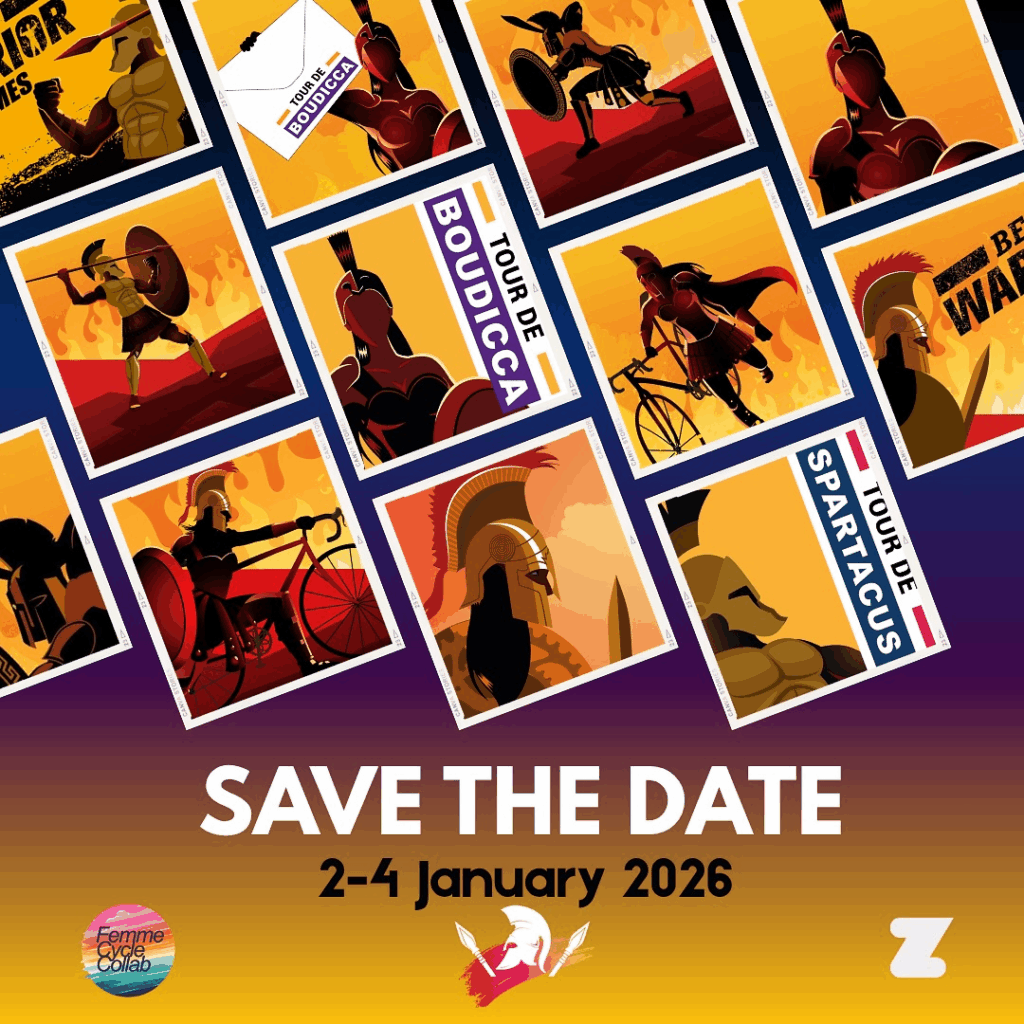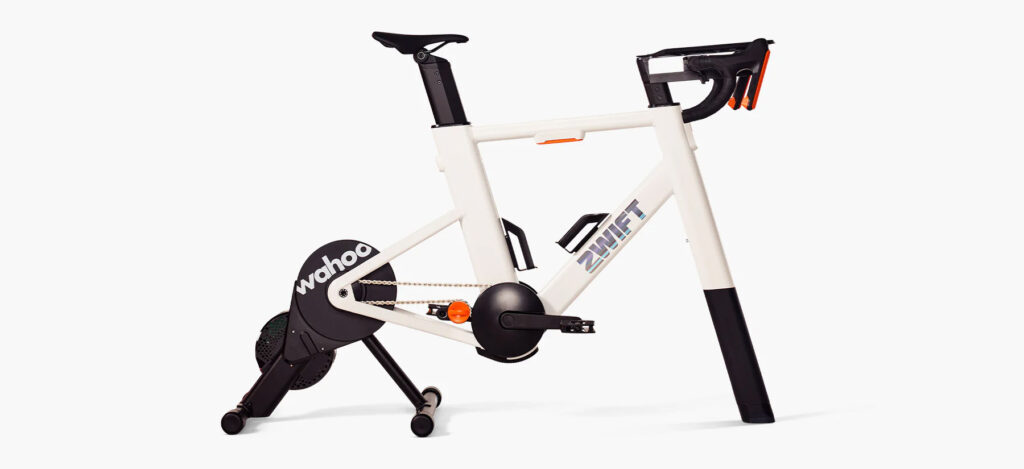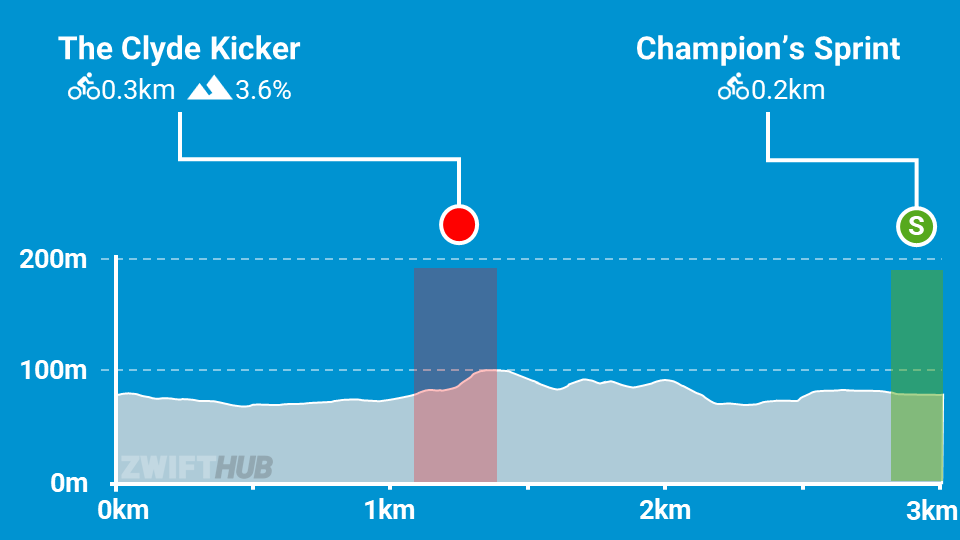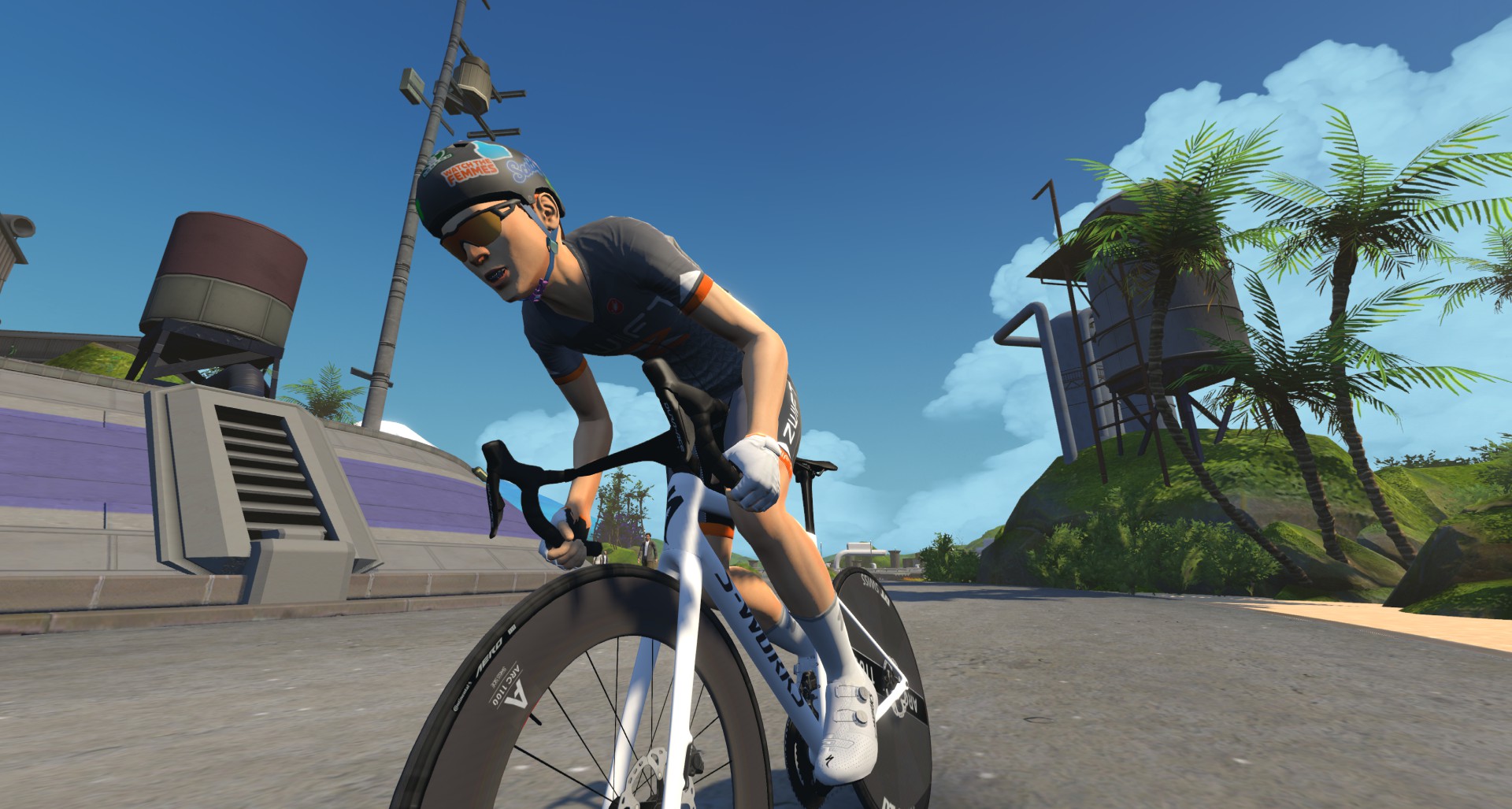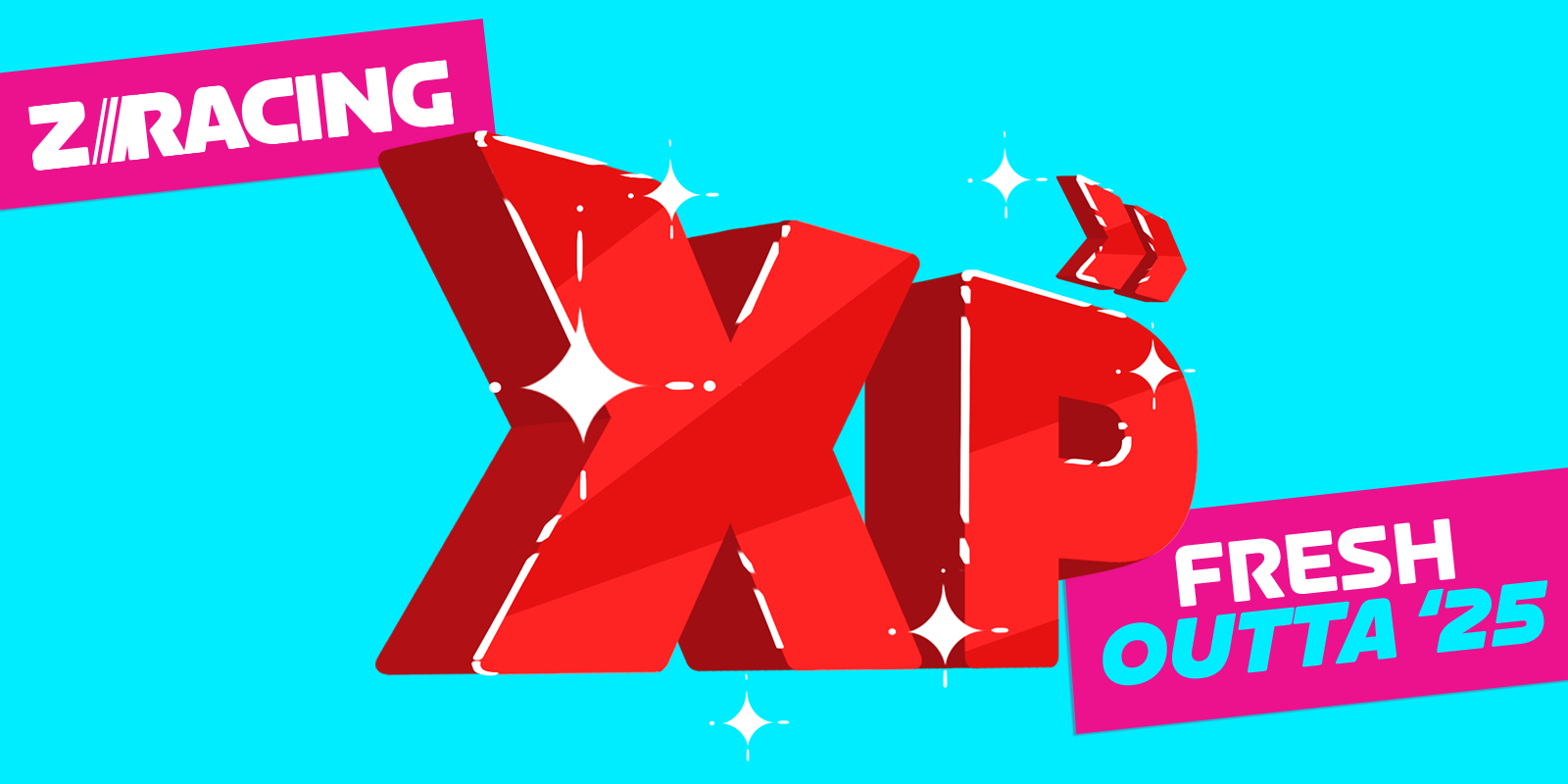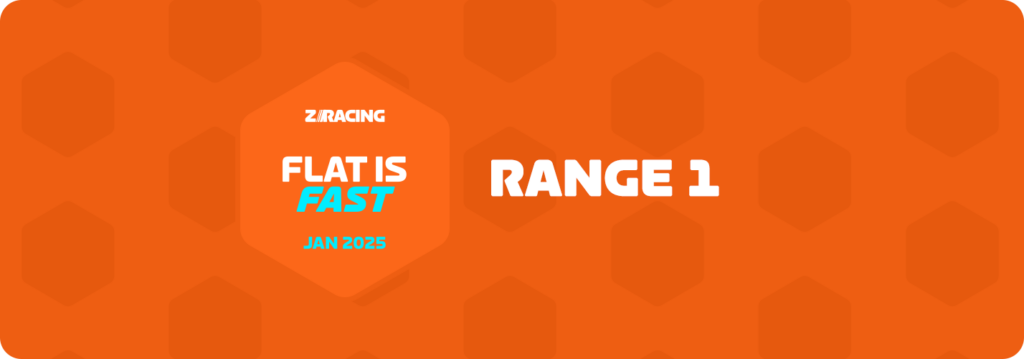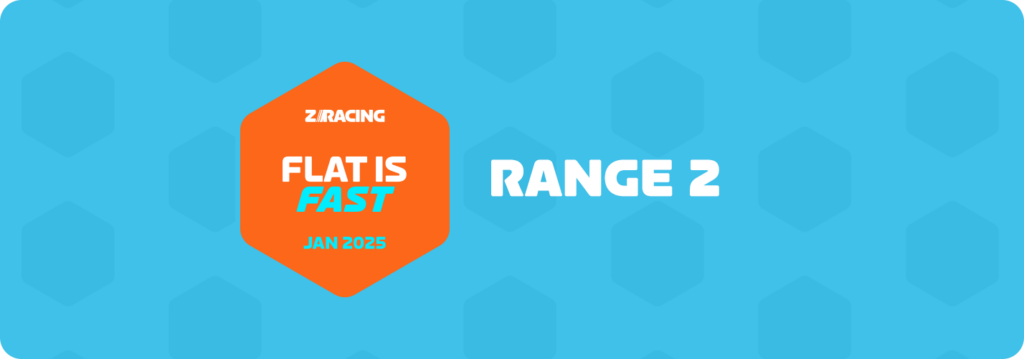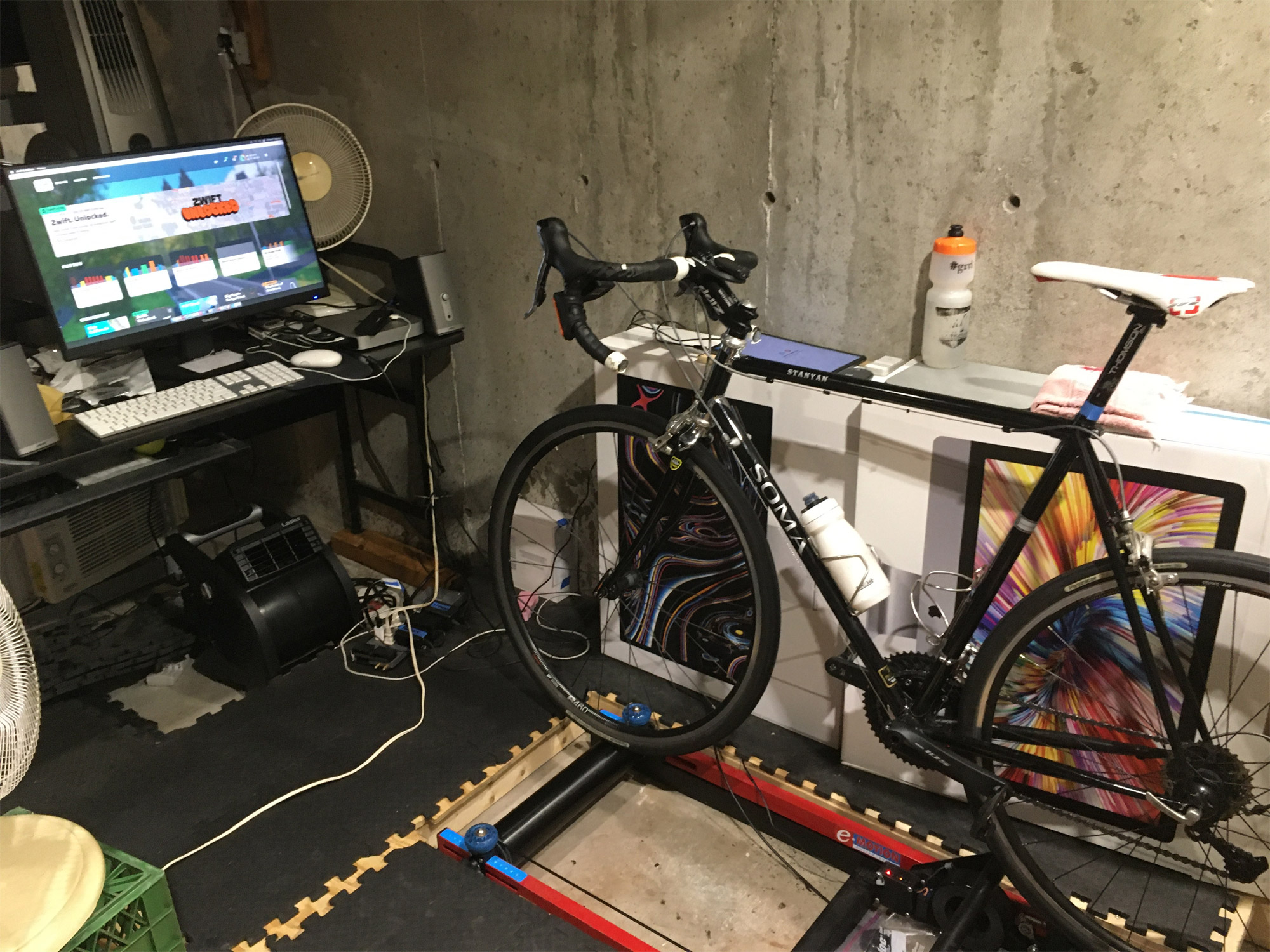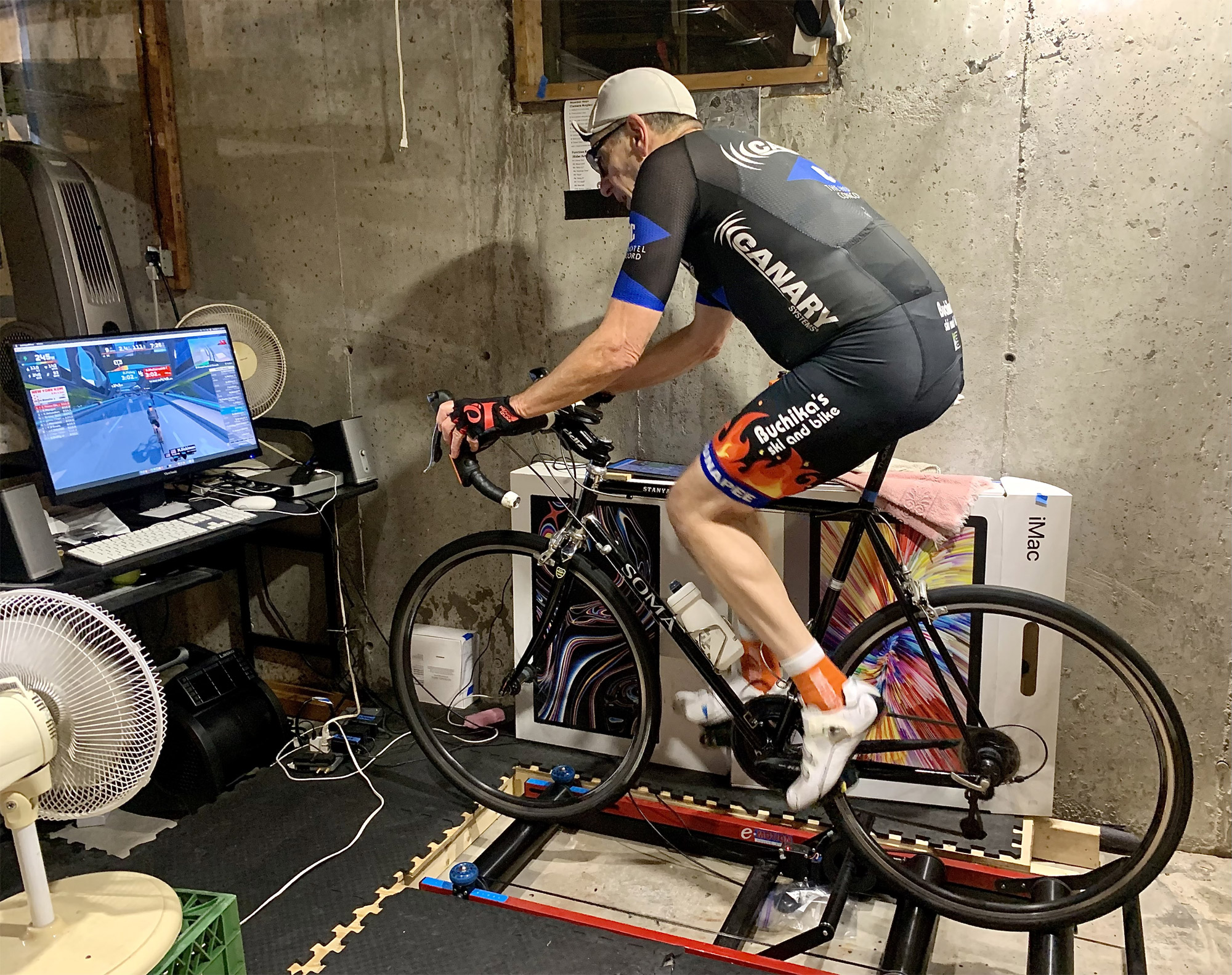How the Race Was Won: Escalator Pandemonium In the ZRL TTT
This week, we took on the new Watts the Limit route in NYC for the second TTT of Zwift Racing League 2025/26. It was a bit of a wild route due to the crazy ramps in and out of the subway, and I didn’t make things any smoother by accidentally sapping my legs in a heat training session the day before.
But I’m getting ahead of myself. Read on to see how our race unfolded!
Heat Training vs Recovery
Let’s start this story a day before the race, when I decided to do a heat training use the CORE sensor. You can watch the whole session here, but I’ll summarize it by saying it turned into a harder effort than I’d planned. But by the time I realized I was probably overdoing it, I was nearly done with Off the MAAP stage 1, and didn’t want to pull the plug. Because I’m not DNFer!
My mistake was confirmed when I pulled up the CORE app and saw this in my activity summary:
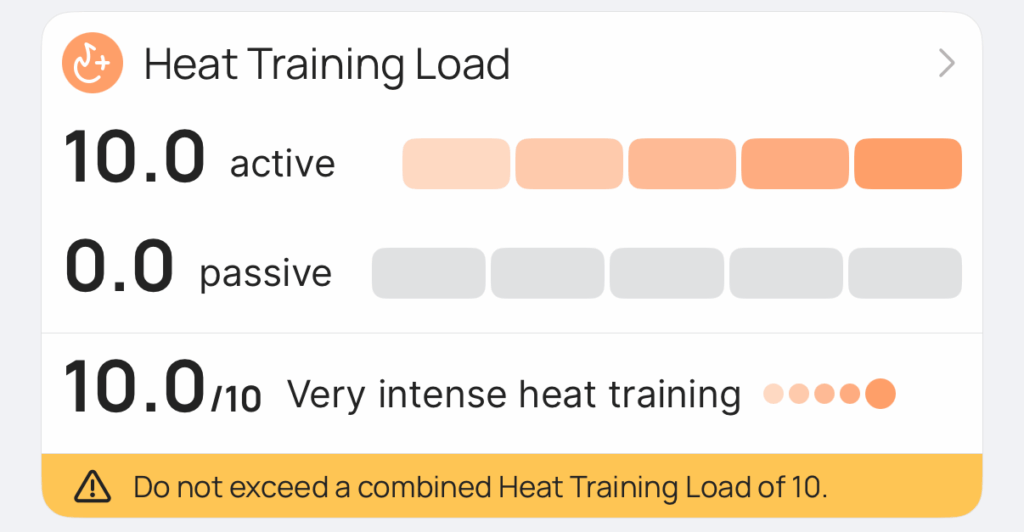
Still, I didn’t feel particularly tired after the effort. I’d only ridden zone 2 power after all. So I just tried to make sure I rehydrated and got rest heading into ZRL day.
Planning Our Race
Heading into the race, my team (Coalition Delusion) was chatting about all things course and strategy as usual. Since these were fairly new roads in New York, none of us had raced them as a TTT yet. Captain Neil had our pull order worked out, with a bit of help from the Zwift TTT Calculator:

The big question for everyone was the escalators. I had already done some testing to confirm that going up the escalators would prove tricky for teams of varying weights, since the escalators slow heavy riders much more than light riders.
Then Zwift made things even more interesting by releasing a drafting fix the day before the race, which particularly affected the ride experience on steep inclines and declines. How would this change the escalators? There really wasn’t time to try it out. We would learn as we went!
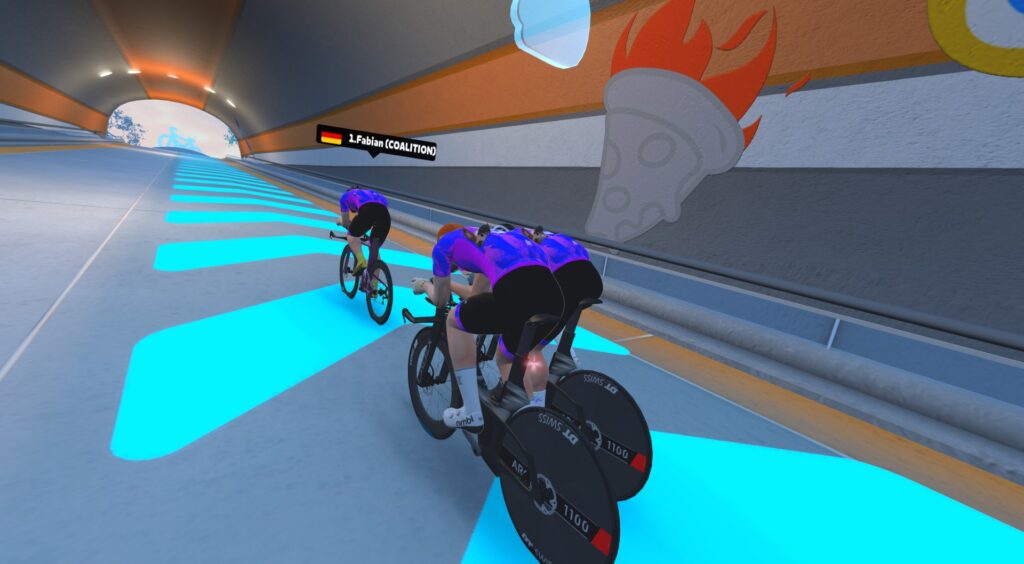
The Race
We took off from the Central Park start pens, and quickly got into formation. Like most TTT squads, our goal is to “line it out” – to hold a 6-rider formation, rotating pulls on the front. It’s absolutely the most efficient way to race a team time trial, and it really is a cool feeling when your whole squad is dialed in and riding as one.
As each rider finished their planned pulls, they would announce on Discord that they were pulling off. Then the next rider would call out how long they’re going, and the on-deck rider would acknowledge that they knew they were there next. We were doing our best to communicate clearly, since we didn’t have a dedicated (non-riding) DS to direct us today.
Calling an Audible
I was supposed to take 60-second pulls, but after my first one (3 minutes into the race) I was already questioning whether that would be possible! It’s not hard to do the math: this would be a ~41-minute race, and the team of 6 would race through in just under 4 minutes. That meant I had at least 10 pulls to make, and possibly more if we lost a rider or two.
I decided I would need to do some shorter pulls to ensure I didn’t blow up on the back half of the course.
Escalator Madness
We hit our first downramp into the subways as I was dropping back from taking my first pull, and I didn’t time things well at all. First, the team flew past me faster than I’d anticipated, which left me a 3 meters off the back as we hit the ramp. I stopped pedaling at the ramp, figuring I would get sucked back into the team via the new, stronger draft… but instead, they rocketed ahead, and I soon found myself 20-30 meters off the back!
Nobody wants to see this view in a TTT:
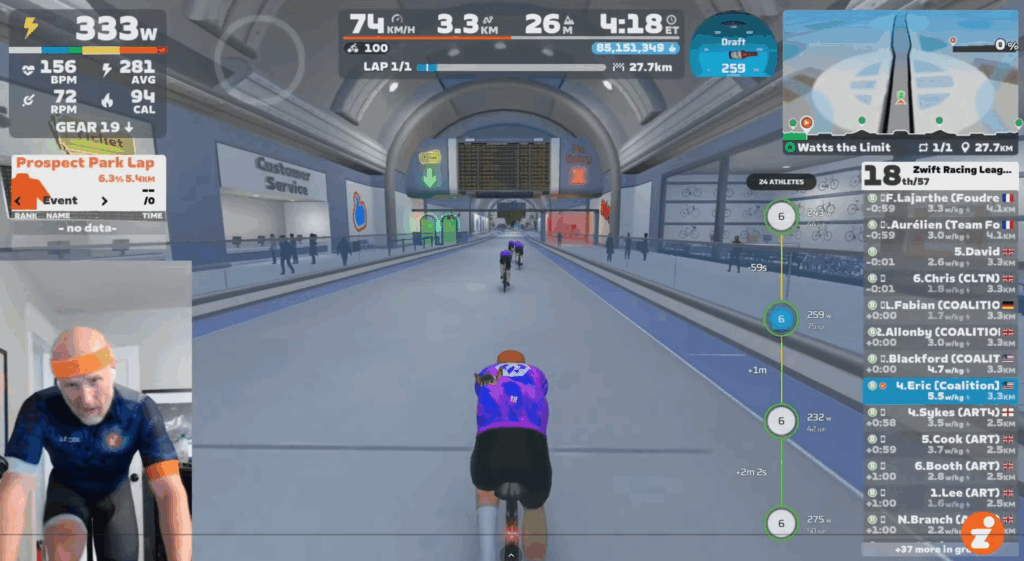
My teammates were quite animated in Discord, surprised by the high speeds and churn caused by the downramp. It was pandemonium, but I hammered to get back in the wheels – you have to react quickly in these situations – and we slid back into formation.
A couple of minutes later, we had our first escalator up and out of the subway. We handled this one much better, with everyone lifting their efforts and our team at least staying tightly packed over the top.
Hammer up the escalator, keep the power high to accelerate once it flattens out, then return to formation. That would be our general approach on the next 5 escalators.
Feeling Weak, Feeling Strong
On my next pull, I only did a 30-second effort. Pushing at what I felt was the typical VO2 max power (~370W) where I take my pulls, the numbers on screen showed 30-40W below my target. Yikes. Clearly, yesterday’s heat session had sapped me.
At the same time, I wasn’t on my limit. This is thanks to being on a B development squad, which means we’re all mid-pack B riders and not a bunch of super-B’s! So I could still contribute to the team in a meaningful way, despite not being on top form. The race began to feel like a tug-of-war between me struggling to pull at my target power, and me feeling strong and perfectly capable in the draft.
At the 9:15 mark, I noticed a gap forming between the two front riders and the four of us behind. (This sort of thing happens to some extent in pretty much every TTT race, and it’s usually triggered by a rider who is dropping back after taking their pull. If that rider drops back too slowly, and someone ends up getting stuck behind that rider, a gap will quickly open up.)
I saw such a gap forming, so I announced I was heading forward to full the gap, and for Robert, the rider whose wheel I would normally sit on in our formation, to let me know when he wanted to come around me to get back into formation. It worked just as planned: the gap was closed quickly, with just a bit of extra work on my part. Let’s roll!
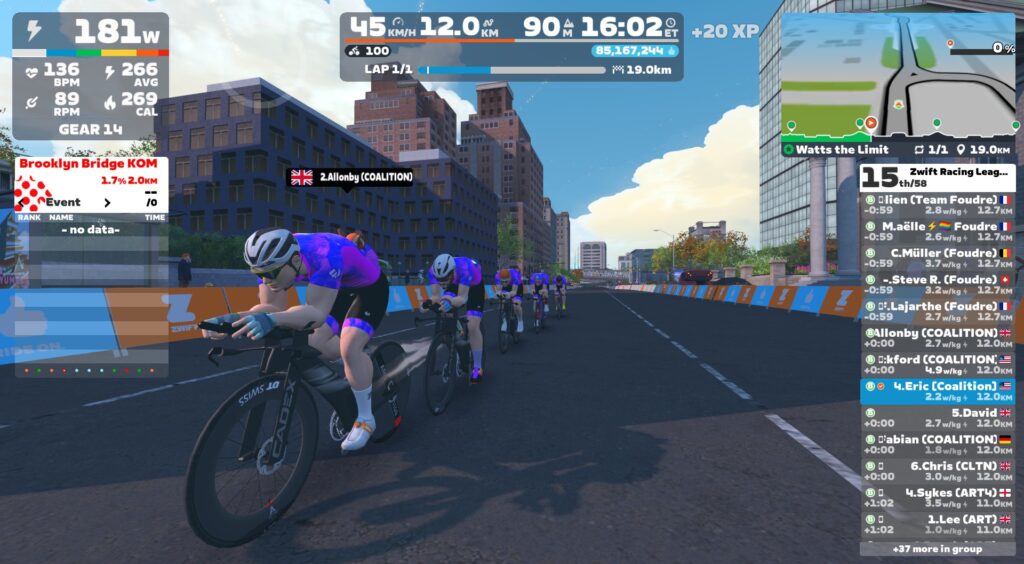
Logging the Miles
The course continued to unfold before us, and we worked together to keep speeds high and ride efficiently. This was far from a flat, steady route! Instead, it was rather polarized, thanks to the six escalators, six steep downramps, and two crossings of the Manhattan Bridge. In between these dramatic sections the course was quite flat, so we were repeatedly transitioning from easy flat roads to major pitch changes and back.
But we were moving well, and Sauce showed us a few seconds up on the teams visible to us: two ahead and one behind – as we made the turnaround at Grand Army Plaza.
No HR
At 16.1km, I noticed my heart rate wasn’t showing in the HUD anymore. Crap. I tried pushing the button to turn it on again, but that didn’t work. It never does, with the Schosche monitor. When it’s dead, it’s dead! Should have charged it beforehand. I just hoped I’d been showing HR long enough that WTRL wouldn’t DQ my effort for the event.
Chris Skips
At 19.1km, Chris said he would need to skip a pull. As a C-cat rider who had been sick in the day leading up to the race, we wouldn’t begrudge him sitting in the wheels for a while! So he slid to the back of the formation, becoming the “bookend” of the group as we started the return climb to the Manhattan Bridge sprint arch.
Back to 1-Minute Pulls
With 8.7km left in the race, I rotated to the front and called out a 1-minute pull. The race wasn’t easy by any measure, but I also felt like I had the legs to do a few hard 60-second efforts before it ended, and the team could use the extra break with Chris unable to pull for now.
(I should mention Fabian here, our strongest rider, who took consistent and strong 1-minute pulls throughout the race. Every team needs a Fabian!)
We hit the downramp into City Hall Station while I was on the front, and while I sort of automatically eased up on the power due to the drop in resistance, the rest of my team slingshotted from my draft and came around me as we hit the flat road at the bottom! We would then have to quickly reorganize into formation while speeds were still high.
This is how the downramps seemed to unfold each time. It may not have been the fastest possible way to attack these ramps, but it was efficient, and we were still putting time into the other teams. The front rider seemingly couldn’t push hard enough to stay ahead on these downramps, as the chasing riders were still putting out power and the newly strengthened draft wanted to slingshot everyone ahead. It was all a bit chaotic, but at least it was fast chaos.
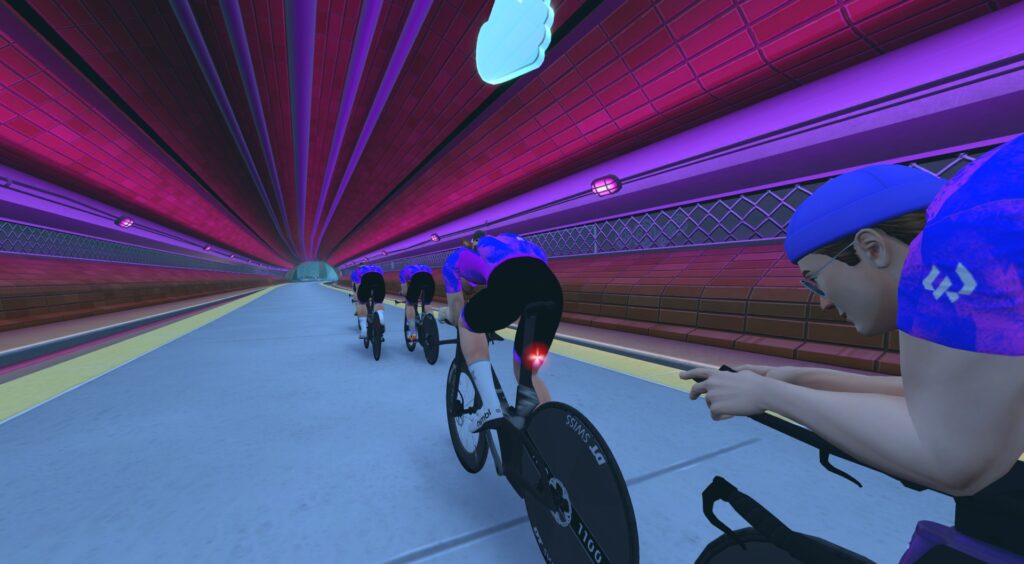
The Finish
We hammered up the final escalator, the longest of the course, and now just 3km were left in the race. The formation was getting a bit jumbled, as often happens near the end of these races.
Chris was still holding on like a boss and volunteered to take a suicide pull to make one last contribution to the team. “Let’s go,” he said with 700 meters left. And he hammered on the front, emptying his tank as we hit the little kicker heading into the finishing sprint.
I hammered up that sprint and tried to keep the power up, as I saw I was the front rider. That always pushes me to give it all, as I know everyone behind is behind helped by my draft!
We finished in 41:37.247, for the win!
Watch the Video
Results and Takeaways
We won by a good margin, beating the next-best team by over 26 seconds:
The problem is, we didn’t do well in races 2 and 3, due to their mountainous nature. So we currently sit in 3rd place overall. But the top of the division is competitive!
Clearly, Coalition Delusion does well with the TTT format. Next week’s punchy points race on Glasgow Crit Circuit will be interesting, to say the least. There’s still potential to improve our overall ranking, but given the last two races of Round 2, it won’t be easy.
One takeaway from this week: I definitely won’t be doing a heat training the day before next week’s race.
We finished our ride with the customary team shot:
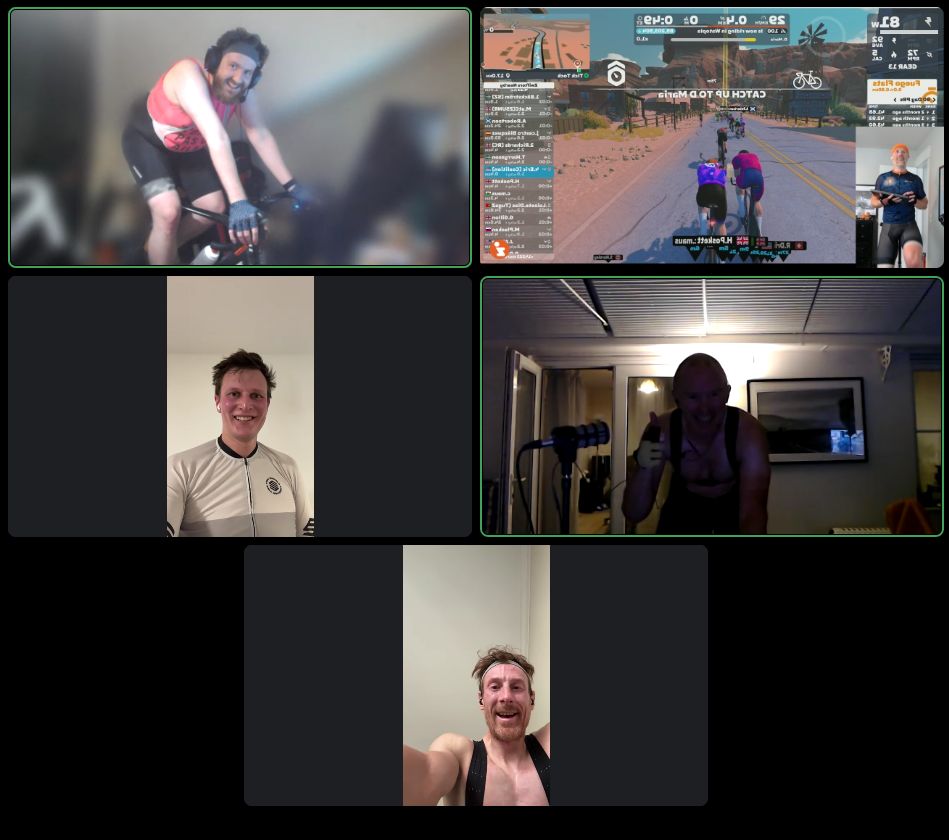
Your Thoughts
How did your TTT go? Share below…





